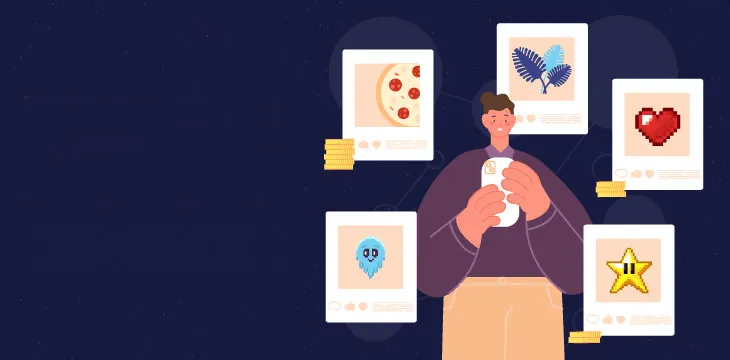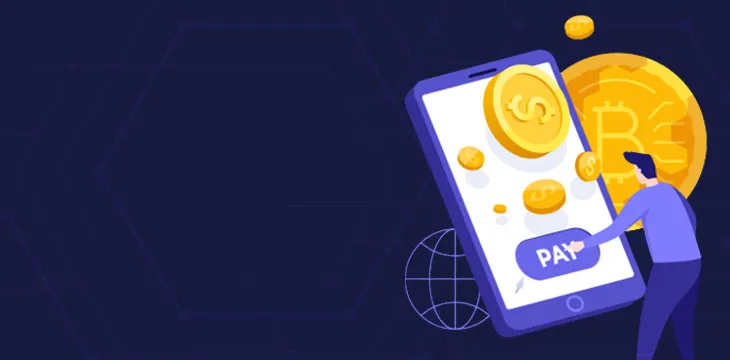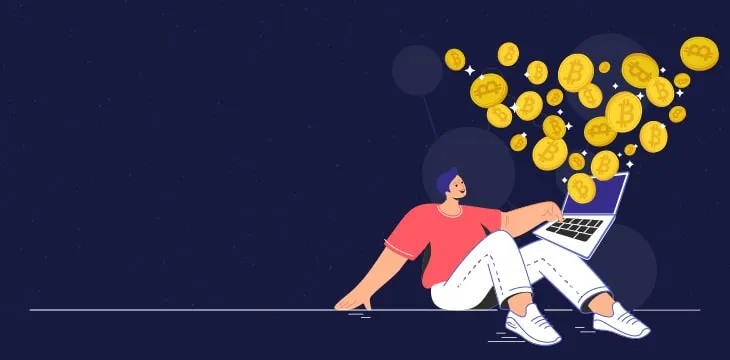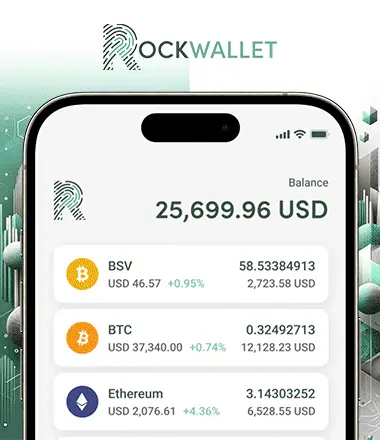The resurgence of NFTs or non-fungible tokens is true evidence as to how dynamic the cryptocurrency industry is. NFTs are not something new in the industry, but we are now witnessing their newfound popularity that has prompted a digital art revolution.
This infographic will serve as a visual guide on NFTs and how this affects you as a beginner in bitcoin. In particular, it will discuss its meaning, key differences from bitcoin, different forms, and how it works. Lastly, it will provide tips for a successful NFT launch.

What is an NFT?
A non-fungible token is a unique, one-of-a-kind digital unit of data stored in a blockchain used to certify the ownership and authenticity of a specific digital or physical asset, including the rights relating to it.
Bitcoin and NFTs
Bitcoin and NFTs can be distinguished by their fungibility or replaceability. Bitcoin is fungible because you can trade it for another bitcoin or on a like-for-like basis. On the other hand, an NFT cannot be swapped for another NFT because each NFT is considered unique, making it irreplaceable.
While bitcoin carries with it intangible value, an NFT represents a real-world asset. The price of each bitcoin is dependent on market fluctuation, while an NFT’s cost is determined by the value the asset represents.
6 Forms of Non-Fungible Tokens
NFTs come in different forms. Here are some of them:
1. Art
NFT has perhaps the biggest implications for the art industry. Masterpieces and artworks are now being traded on NFT platforms, and creators and artists have made profits by auctioning their NFT art. Most digital artworks are stored on separate website servers, while physical masterpieces are kept in galleries, art halls, art clubs, and the like.
2. Real-world items
Real-world items such as land and real estate property are now making waves in the NFT scene. For instance, in fractional ownership, homeowners can sell part of their property to investors by issuing tokens. This affords the investors certain benefits such as income sharing, priority access, and reduced rates on the use of the property.
3. Images
Photographs can now be tokenized, thanks to NFT. If you are a photographer, you can sell the ownership rights of your images by issuing a certificate. You can also attach a royalty agreement to your NFTs, which entitles you to a percentage of the profits made every time your NFTs are sold to someone else.
4. Videos
Video NFTs are just as artful and collectible as photographs. Video creators can now sell 10-second clips for an amount that can go as high as $6.6 million. Recently, TikTok entered the world of NFTs with the release of its collection of digital assets inspired by trending videos.
5. GIFs
GIFs have been around for some time, and now they have made their way to the realm of NFTs. These animated images can now be minted for authentication to be exchanged and monetized. Last March, a link to a GIF was sold for $25,000 at an Ethereum auction within 24 hours after the GIF was stored on the blockchain.
6. Music
Using NFT platforms, artists can now put out their new music on the blockchain, allowing fans to instantly access and buy the material.
Some platforms provide the option of embedding a royalty share, enabling fans to earn money from the music they love by simply promoting it on social media. This arrangement is a new and exciting way for musicians and their supporters to connect and interact, helping create a better music industry for everyone.
How Does It Work?
NFTs are created and stored on blockchains. They represent physical and digital goods that have been “tokenized” and assigned unique codes as proof of their authenticity. When someone purchases an NFT, they buy a token representing the asset.
Once the buying process is completed, the ownership gets recorded on the blockchain, and in no way can it be tampered with. This allows anyone on the blockchain to verify and trace the authenticity of the ownership.
The introduction of NFT has allowed creators and artists to monetize their work without having to deal with an intermediary like an art gallery or record label. This leveling of the playing field helps remove the friction that exists in the industry and makes fine art so expensive. It has also provided another way for buyers to support their favorite creators, as NFT platforms remain accessible to everyone in the digital space. Beware that given the industry is in its infancy, many NFTs may attempt to sell you rights to an asset that they have no rights to convey, or otherwise sell you an empty token without any legal rights. Please do proper research into your marketplace and the NFT issuer to ensure that the token you are buying actually has enforceable legal rights attached to it.
Why Good Platforms and Marketplaces are Important to NFT Success
A good platform plays a key role in the success of NFT. Here’s why:
- Fragmented and varied platforms prohibit the market to emerge
For an NFT platform to thrive, there needs to be one marketplace where everyone can create, sell, and transfer their NFTs. Ethereum uses this umbrella-type framework in OpenSea, integrating an agreed-upon economic epicenter in the platform. On the other hand, the trading environment being fragmented with different protocols, restrictions, and marketplaces makes it challenging for the market to emerge.
- Increase market users and participants
>Increasing NFT market participants is pretty much like marketing a real-world product. You need to first build brand awareness and trust before you can attract new users. As mobile phones become increasingly indispensable in everyday life, leveraging this opportunity by creating marketplace apps will help drive customer engagement, enabling the market to flourish.
- Attract high-profile members
Ethereum has a community of high-profile members, including celebrities, business magnates, and other public figures. This partly accounts for the platform’s success. When an influencer or personality mentions an Ethereum-based project that has a limited supply to their audience, the platform can better attract new users.
In this instance, the ripple effect continues. New users will spread the word about the project, prompting others to enter the market. Ultimately, this increases the value of the asset.
- Build a community
Building a network of loyal and committed members is an important element of a successful NFT platform. The key to doing it right is by offering the membership to a defined audience. The concept of blockchain may probably sound novel for most outsiders, so using varying approaches will help facilitate community-building efforts.
8 Tips When Doing NFT Transactions
Here are tips when dealing with NFTs, especially if you’re a beginner:
For sellers:
1. Promote your work
Marketing is a key factor for a successful NFT launch. Blogging, for instance, can be an effective way to promote your work. Collaborating with other artists or creators can also help widen your market reach, as it introduces you to your collaborator’s audience.
2. Leverage social media
NFT galleries usually have their groups and pages on social media platforms like Twitter, Telegram, and Discord. Leverage the power of technology by staying active on these channels. Engage with your followers by sharing updates about your upcoming projects. Connect with your fellow artists by participating in forums to enrich your knowledge and foster collaboration.
3. Launch your NFT on the most popular NFT marketplace
Launching your NFT on the leading marketplaces will give you exposure to a larger audience. OpenSea, Rarible, and SuperRare are some of the most popular NFT trading platforms being used by traders, investors, and creators. These spaces are considered part of the NFT high street where digital art and collectibles are sold at every conceivable price point.
4. Target collectors
If you’re on major NFA platforms, chances are collectors are there, too. Take advantage of the opportunity by seeking them out and then making a competitive proposal.
For buyers:
1. Have a digital currency wallet
Before you can begin buying an NFT, you need a digital currency wallet where you can transfer money to set up your funds. Make sure the wallet integrates with the NFT marketplace you’re looking to buy from.
2. Check the payment methods
Most marketplaces accept only Ether as payment since most NFTs are Ethereum-based. However, some NFT game platforms accept credit or debit card payments, such as NBA Top Shot. Before proceeding with the purchase, be sure to check first which digital currencies can be used to buy the NFT.
3. Be aware of transaction fees
Each NFT purchase comes with transaction fees. These include gas fees, which vary according to your blockchain choice. In some marketplaces, they charge fixed fees on top of your order totals. When buying NFTs, remember to check the associated fees before clicking the “Checkout” button.
4. Mint the NFT at the date and time it is released
A good rule of thumb when buying an NFT is to purchase it at the date and time it is released.
Otherwise, you may be paying a marked-up price! Keep in mind that non-collectors resell NFTs at a cost higher than their original price, so be sure to always stay in the loop for the best finds.
NFTs are Here to Stay
NFTs have exploded in popularity over the past year, attracting thousands to jump on the bandwagon. One reason for this is their verifiability that allows traders to confirm their authenticity. This alone is a novel innovation that gives the market legitimacy points.
NFT crypto art, in particular, is revolutionizing the world of art, providing a different and exciting mode of collaboration between creators, artists, fans, and investors. Given its promising potential, it is regarded by many as the new frontier of revenue generation. This new disruptor is taking the world by storm – one Ether at a time – and is here to stay.
If you want to know more about blockchain and bitcoin, CoinGeek is the perfect place for you. Our resources explore bitcoin for beginners, providing everything you need to know about this digital currency, including key terms and their definitions as well as blockchain basics.
Recommended for you
Tiny payments are changing the expenses landscape. Micropayments and nanopayments are not entirely new concepts and practices. But with the
You can earn money when you explore the world of Bitcoin and understand its intricacies. Once you get the hang

 09-13-2025
09-13-2025 



